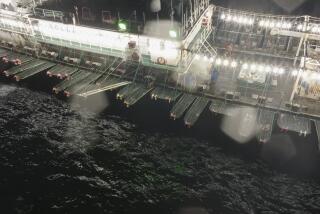Franz Hoskins, 86; Part of Non-Doctor Team on Sub That Did Appendectomy
- Share via
The appendectomy took two hours and 36 minutes and 16 times the ether a real doctor would use--enough to make the whole five-man amateur operating team groggy.
The setting was equally bizarre: officers’ mess in a submerged submarine during World War II behind Japanese enemy lines 2,000 miles from the nearest Allied port and surgeon.
No wonder the saga made history [first appendectomy performed underwater], earned a Pulitzer Prize for the telling and formed the basis for a television show.
Dr. Franz P. Hoskins, the lieutenant who poured ether through gauze and a large tea strainer that September day in 1942, years before he went to medical school and became a family physician, has died. He was 86.
Hoskins, who became a submarine commander before practicing medicine for 40 years in Tacoma, Wash., died of cancer Nov. 8 in Kingsport, Tenn.
“One thing I learned [in medical school],” he said in 1987, “you can do an appendectomy with three ounces of either. I used three pints on the Seadragon.”
The unlikely surgery was prompted by dire necessity.
“It was operate or certain death, for the patient had a temperature of 106 degrees,” Hoskins wrote in a letter home in November 1942, which was reprinted by the wartime news media hungry for happy stories.
One reporter who expanded on the tale, George Weller of the Chicago Daily News, earned a Pulitzer Prize for his version that appeared Dec. 14, 1942, datelined in wartime parlance “Somewhere in Australia” and beginning with the cryptic: “ ‘They are giving him ether now,’ was what they said back in the aft torpedo rooms. ‘He’s gone under, and they’re ready to cut him open,’ the crew whispered sitting on their pipe bunks cramped between torpedoes.”
When the Navy submarine fleet became the stuff of a syndicated television series in the late 1950s called “The Silent Service,” the impromptu appendectomy was naturally restaged in a much-loved segment.
“You know, we have experienced many a rare event in this last year: bombings, depth charges, torpedo fire and all the like,” Hoskins wrote in his 1942 letter home, “but one of the rarest yet recorded out here was one that took place on board our little ‘home.’ Yes, siree, the mysteries never cease. Our pharmacist’s mate, plus the executive officer, myself and two machinist’s mates, performed a successful appendectomy. Yes, siree, there’s one for the records. The only one of us who even seen [sic] an operation performed was the pharmacist’s mate. I performed the anesthetic and encouraged the ‘doc’ and the executive officer along as they were doing the actual cutting and digging.”
The surgical team kept in touch, and when three of them were together in Las Vegas for a reunion of U.S. Submarine Veterans of World War II in 1997, Hoskins still sounded awe-struck by their required daring. “That day is still vivid in my memories,” he told the Las Vegas Review-Journal. “I could never forget that.”
Wearing inside-out pajamas soaked in alcohol squeezed from torpedoes, Hoskins performed the makeshift anesthesiology by reading instructions in a medical manual and following directions from the pharmacist’s mate-cum-surgeon, Wheeler Bryson Lipes.
Only after becoming a doctor did Hoskins realize the threats blissfully unknown to the little submarine surgeons--among them potential staph infection or peritonitis.
The patient, Darrell Dean Rector, not only lived but woke up half an hour after surgery complaining of hunger, and returned to duty 13 days later. He died in the war on another submarine when one of its torpedoes malfunctioned, turned around and blew up the ship.
“We were all affected when we heard that,” Hoskins said years later.
Hoskins, who interrupted his studies at the University of Washington to join the Navy in World War II, was second in command of the Seadragon when Rector suddenly required the amateur surgery. The lieutenant later became the first reserve officer to command a submarine on war patrol, the Trutta.
Although he denied that his experience as an unschooled anesthesiologist had anything to do with it, Hoskins returned to the University of Washington and earned his medical degree. He said he could never have afforded the training without the GI Bill of Rights, which helped returning military pay for college educations.
Despite a heart stoppage after open-heart surgery in 1979, Hoskins continued working until he was 80 and only a year ago won a ballroom dance contest at 85.
Widowed by the death of his wife of 45 years, Noreen, Hoskins is survived by two children, Nancy Hoskins and Dr. Franz Hoskins Jr.
More to Read
Sign up for Essential California
The most important California stories and recommendations in your inbox every morning.
You may occasionally receive promotional content from the Los Angeles Times.












